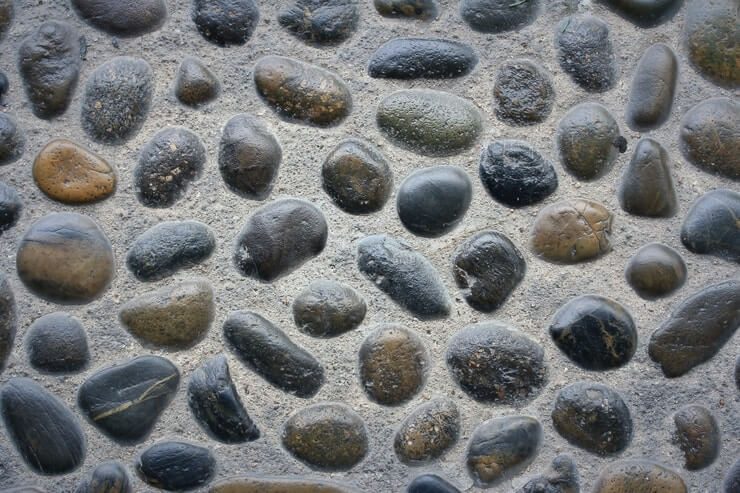Pebble shower floors give you a look that is authentic to nature. But what do you do when your river rock flooring begins to come loose?
These loose stones may turn your beautiful stone flooring into a tripping hazard, not to mention the cosmetic issues and possible water damage to your subflooring.
This article will show you how to repair your river rock flooring to return it to its original condition. Whether through repairing specific loose stones or by replacing the floor in its entirety.

How to Repair Loose Pebble Shower Floor (2 Methods)
1. Remove Pebble Floor and Reinstall It
If your pebble shower floor was installed poorly or if the grout itself has wholly given away, you may have no other option but to remove your river rock floor and reinstall it completely.
If the majority of your stones have become loose or you have a severe mold issue, completely reinstalling your flooring is the best option.
This is a costly option indeed with respect to your time and money and should only be done as a last resort.
How to Remove a Pebble Shower Floor
- Decide whether you’re going to keep the old stones, buy new ones or use a combination of new and old stones.
- Begin removing the grout. This could be done carefully with a chisel and hammer or more aggressively if you decided not to keep your old stones.
- Begin removing your stones by placing the chisel underneath your stones and removing them one by one.
- Once your grout and stones have been removed, use your chisel to remove the mortar with care not to damage your subfloor.
- With the grout, stones and mortar removed, use a shop vac to clean up any debris left behind.
- Ensure that you have a flat, clean surface in order to install your new river rock flooring properly.
The following article will provide you with detailed information on how to install a pebble shower floor.
2. Repair Pebble Shower Floor
If only a few pebbles or stones have become loose in your flooring, a much more cost-efficient option would be to simply repair the loose stones.
Whether your stone flooring was installed over a poor foundation or you did not regularly seal your pebble shower flooring, some stones can become loose.
If your stones are only loose near the shower’s drain, there is likely additional work required to solve the problem.
How to Repair a Pebble Shower Floor
- Begin by identifying the trouble areas of your floor and identify possible causes of your loose stones.
- If the pebbles are loose enough to remove by hand, do so. Otherwise, carefully remove them along with the grout using a chisel and hammer.
- With the pebbles removed, use a waterproof sealant in all removed and affected areas to protect your floor.
- Wait for the sealant to cure fully.
- Apply a thin-set mortar or adhesive as recommended by the river rock manufacturer.
- Apply the stones to your floor in the pattern that is best fitting and stylish to you.
- Install grout over your newly installed stones.
- Apply a second coat of sealant over the river rock flooring as necessary.
The following article will provide you with detailed information on how to grout your pebble stone flooring.
How to Prevent Pebbles From Coming Loose
Some of the ways to prevent your pebble shower floor from coming loose in the first place begin with the installation process itself.
If your floor is not properly sealed, water can penetrate your flooring and affect your mortar or adhesive, causing your stones to become loose. The same issue can arise with poorly installed grout.
One major way to avoid loose river rock flooring is to make sure your floor is installed correctly and that you follow all of the manufacturer’s directions and recommendations.
The other way to prevent pebbles in your stone flooring from coming loose is through dedicated maintenance.
Your river rock flooring will require regular resealing every six months to one year. Forgetting to reseal your floors may cause water to penetrate your stones and cause loose pebbles.
Also, routinely cleaning your pebble shower floor will keep away mold and mildew, which can also cause your stones to become loose.
Establishing a regular cleaning and resealing routine can prevent your stones from coming loose, saving you money and time.
FAQ
Pebble stone shower floors are not built to last forever. Most river rock floors will last between 15 to 20 years before requiring a major repair or replacement, even with proper care and maintenance.
Some would argue that it is possible to tile over a pebble shower floor. It is not something that I would recommend.
Pebble tile flooring will create an uneven surface that will be hard for tile to adhere to. Additionally, If you have some type of leak into your subfloor, you would have two layers of flooring to deal with.
This will depend on how often your shower is used and which type of grout you installed. But in most situations, you should reseal your river rock flooring every six months to one year. Resealing your pebble shower floor is vital in giving it a long lifespan.

